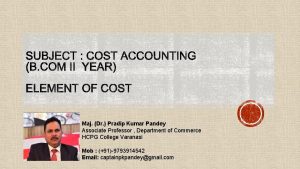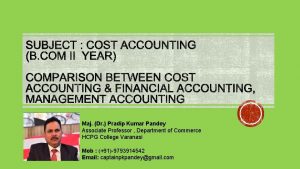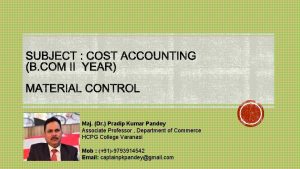Maj Dr Pradip Kumar Pandey Associate Professor Department






- Slides: 6

Maj. (Dr. ) Pradip Kumar Pandey Associate Professor , Department of Commerce HCPG College Varanasi Mob : (+91)-9793914542 Email: captainpkpandey@gmail. com

SYLLABUS : UNIT – I Nature and Scope of Cost Accounting, Cost Vs. Management Accounting, Elements of Cost and their Classification, Methods and Techniques, Installation of Costing System, Concept of Cost Audit. Accounting for material: Material Control, Techniques, Pricing of material issues, Treatment of material losses. UNIT – II Accounting for Labour: Labour Cost Control, Procedure, Labour Turnover, Idle Time and Overtime. Methods of Wage Payment-Time and Piece rates, Incentive Schemes. Accounting for Overheads: Classification and Departmentalization, Absorption of Overheads, Determination of Overhead rates, Under and Over Absorption and its treatment UNIT – III Cost Ascertainment: Unit Costing Job Costing, Batch Costing, Contract Costing. UNIT – IV Operating Costing, Process Costing, Cost Records: Integral and non-Integral System; Reconciation of Cost and Financial Accounts.

INTRODUCTION : Industrial Revolution followed by Technological Revolution led to the existence of many manufacturing industries across the world. Entrepreneurs face cut throat competition for their survival. One of the important factors for any industry is “Cost” and it is obvious that every manufacturer has to do effective planning and control of cost for its entire operations. This cost-consciousness necessitated the accountants to device a new technique of accounting which resulted into birth of Cost Accounting. Today the world has become global village. There is a sea change in the business environment. In order to survive in this global economy, business must have competitive edge over others. This objective can be achieved if the business is inclined towards a. ) Cost Effectiveness & b. ) Quality Consciousness. Cost effectiveness a d quality Consciousness are important elements in determining the success of a business enterprise

MEANING : Accounting serves the purpose of providing financial information relating to activities of the business. Such information is provided to shareholders, managers, creditors, debenture holders, bankers, tax authorities and others. Broadly speaking, on the basis of type of accounting information and the purpose for which such information is used. ACCOUNTING FINANCIAL ACCOUNTING COST ACCOUNTING MANAGEMENT ACCOUNTING Financial Accounting: It is mainly concerned with recording business transactions in the books of account and prepare i) Profit and Loss Account showing the net profit or loss during the year and ii) Balance Sheet showing the financial position of the company at a point of time. Cost Accounting: Cost Accounting is the classifying, recording and appropriate allocation of expenditure for the determination of the costs of the products or services and for the presentation of suitably arranged data for purposes of control and guidance of management. Management Accounting: It is the modern concept of accounts as a tool of management. It is to concerned to all such accounting information that is useful to management

LIMITATION OF FINANCIAL ACCOUNTING: Cost accounting has emerged mainly because of certain limitations of financial accounting. Financial accounting is so limited and inadequate in regard to the information which it can supply to management that businessman have been eager to adopt supplementary accounting system like cost and management accounting. The limiattions of financial accounting are summarised as follows: 1. Shows Only Overall Performance: 2. Historical in Nature 3. No performance appraisal 4. No material control system 5. No Labour Cost Control 6. No proper classification of cost 7. No analysis of losses 8. Inadequate information for price fixation 9. No cost comparison 10. No data for comparison and decision making 11. No clear idea of operating efficiency Financial accounting will not help to answer such questions as (a. ) Should an attempt be made to sell more products or factory is operating to its capacity? (b. ) Why the profit of last year is of such a small amount despite the fact that output was increased substantially (c) If a machine is purchased to carry out a job (earlier done by hand ) what effects will this have on profits?

THANK YOU !











